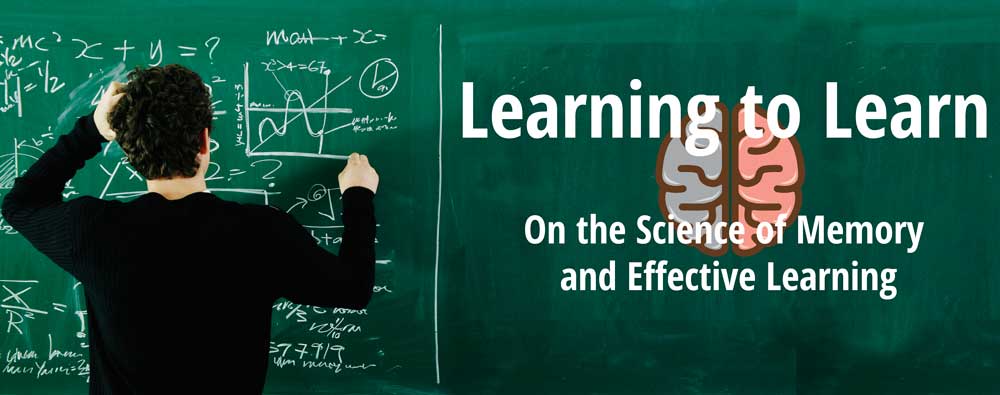One of the most useful and interesting things I learned in the last year was not so much a specific subject or skill but a meta-skill. I learned how to learn.
Learning is a critical skill for everyone. Whether you are a full time student, working full-time or retired, learning is an important aspect for people living in a constantly changing and complex world today. If your full-time job is studying or just spend a few hours a week learning new things like I do, certain study skills and learning techques can help you to learn more effectively. Additionally possessing an understanding of what is learning and how our memory works will help you understand why certain learning techniques work and how to adapt your lifestyle and health towards improved learning, thinking and creativity.
As a life-long and constant learner, I’m always learning new things. I have a love for foreign languages, technology and the social sciences, like philosophy, psychology and sociology. As my blog writings document, I’m often writing about the things I’m learning too. Ironically I’ve come to realize that this act of blogging what I learn (or giving or teaching, for that matter) is one of the better ways to learn. Elucidation forces you to engage with a topic, figure out gaps in your knowledge, connect it to what you know, and put it into a meaningful ordr or story. Unfortunately some of the other ways I like to use when learning like highlights and summarizing are not great learning methods and even promote something called the illusion of competence.
To the cut to chase, the best course I took recently was Learning How to Learn, a free course available on Coursera. I highly recommend it to everyone. The course is taught by Professors Barb Oakley and Terry Sejnowski. Oakley focuses more on the practical aspects of memory and thinking, while Sejnowski digs more into the neurology and brain science behind what happens in memory and learning.
Along with a lot of great material, links and resources, the course offers an example of “practice what you preach,” meaning the course provides great analogies, metaphors and visualizations of the more complex concepts. These funny examples and metaphors provide a way to “hook” new concepts into your memory and make remembering key concepts easier. Additionally, in view of how research reveals the importance of testing, intermingling, and elaboration to learning, it’s no surprise you get several ways to engage with the learning in the course by taking quizzes, doing homework, and connecting concepts together. My big takeway is I know that I can get better at learning and now know many ways how to do it.
In this post, I want to share some of the lessons I picked up from learning how to learn, both from this course and from additional research. In the first section, I’ll argue for why everyone should learn how to learn and some of the benefits to understanding your learning apparatus. After that, I’ll share a few resources I use to learn more about learning. As a technologist, I’ll also share some of the tools I use to learn languages, new theories and coding. Finally, in the longest section, I’ll offer a summary account of what is learning and how memory works as well as a few things we can do in our lives to optimize both.
Hopefully by the end I’ll have convinced you to improve your learning and your understanding of learning as such.
Let’s get started looking at one of the most important meta-skills we all can improve: our ability to LEARN!
Why You Should Learn to Learn
The core reasons why you should learn to learn are so that 1.) you can discover what doesn’t work well for learning, 2.) you can know what are the most effective techniques that do work for learning, and 3. you can become aware of how important lifestyle factors are for our memory. Basically learning how we learn will show you how you go from being exposed to a new concept to eventually forming long-term neurological connections that we call memory you can use.
I consider myself a life-long learner. In the last year I taught myself two new programming languages, gained an intermediate level in machine learning, and went deep on the science of goals, habits and personal finances. I also dabbled in learning chess and now know a few hundred words in Thai. But to be honest, in view of how important learning is to me, it’s unfortunate how little I previously knew about memory and learning. I considered myself a good learner and figured that I was already learning stuff, so what more did I need to learn about learning?
Learning skills are key for both students and today’s knowledge workers as well as just about anyone who needs to pick up and master new concepts frequently. The fact is that most of us have to deal with a changing world and learning and dealing with new information are critical skills.
Unfortunately, the reality is that many of us are carrying around some pretty antiquated learning methods. Our learning methods are often far from optimal and worse they might be giving us an illusion of learning rather than actually helping us learn.
You might be suprised to learn that some of the most popular techniques for learning are not very effective, according to numerous studies. In “Strengthening the Student Toolbox: study strategies to Boost learning” (2013), researchers reviewed the claims backing up several different learning methods. Their conclusions point out that many common methods students use like re-reading, highlighting and underlining and summarization are not very effective. They just don’t work very well.
Worse still, these methods promote what is called the illusion of competence. The illusion of competence describes the feeling where we think we know or have learned something when in reality we have not. Ultimately it is a failure of self-monitoring and feedback. We are getting the wrong feedback that we have learned something, instead of the right feedback that we need to continue practicing. There are a group of study activities like re-reading and highligting that are noteable in how they give you this feeling of mastery and learning but don’t provide proper feedback to show you haven’t actually learned. These methods aren’t necessarily completely bad, but they are not the most effective.
In contrast, the best learning techniques force you to engage with the things you are learning. They provide feedback if you have gaps, haven’t learned something or mislearned. Research indicates the best learning methods are testing, elaboration and self-explanation. They are best applied through a couple of learning strategies, like scheduling, distributing and mixing up your practice and study time. Reseach indicates the benefits of spacing your studies out over time and being sure to mix up different concepts instead of focuing on a single area.
Learning is about recall, so forcing yourself to recall (like with flashcards), elaborate or take tests prove effective since that’s how our minds work. One example of elaboration that I like and use comes from Physicist Richard Feynman. The Feynman Learning Technique works like this: you take something you want to learn and study it until you are able to present and teach it. If you can’t teach it, you haven’t learned it. This method involves a degree of simplification. So you cycle through multiple learning stages to discover gaps in your knowledge when you try to teach it. Once you can teach it, you’ve mastered it.
Besides dispelling the illusion on techniques that don’t work and discovering a few that do, another key reason I think everyone should learn about learning is to understand the context in which learning takes place inside of our brains. Learning is a biological process and various lifestyle factors have an important impact on our memory. We aren’t computers that can insert a USB stick or download a file and then claim to have learned something.
Learning changes our brains. We have to literally incorporate new information into the network of connections in our brain. While part of the learning process does happen when we read a book, take notes and do a practice test, the actual building of connections takes place while we sleep. In fact, good health, sleep, nutrition and exercise are all just as important as the actual act of learning.
So, in summary, why should you learn about learning? First, you can dispell some illusions on what doesn’t work for learn. Second, you can discover some of the best learning techniques which force you to recall, build connections, and help you discover what you don’t know yet. Third and finally, you learn what actually happens in your brain when you form a new memory. Also once you know the basic steps of learning, you’ll realize why how you live is just as important as how you learn.
Resources for Learning to Learn
In the last section, we looked at why you should learn to learn. In this short section, I want to share some of my favorite learning resources.
The first and best resource I recommend for anyone on this topic is the course I mentioned in the intro: Learning How to Learn: Powerful mental tools to help you master tough subjects. It’s free and available on Coursera. High-level you’ll learn what goes on in our brains when we learn, what a learning chunk is and a few techniques that help you learn like pomodoros, metaphors, stories and deliberate practice. For me, I came to understand how important sleep and exercise are for learning, and I became much more aware of how I need to be healthy and well-rested if I want to learn and be creative.
One key concept I picked up was about our two primary ways of thinking: the focused and diffuse modes of thinking. We need to develop and leverage both of these systems for successful learning (as well as for creativity and innovation).
Focused and Diffuse Mode of Thinking and Learning
Here is a paricularly illustrative way of thinking about these two systems:
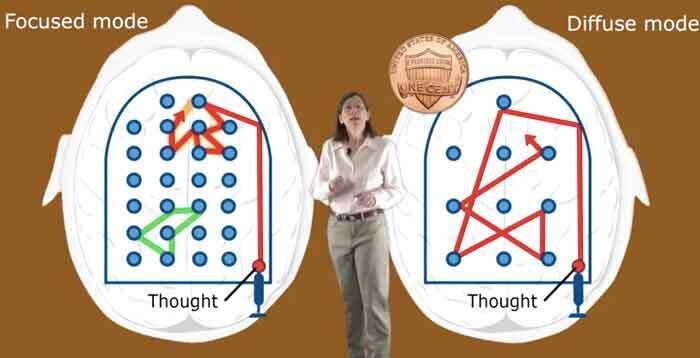
On left we see the focused mode. The focused mode is about bringing together related concepts into a unit, which is called a chunk. This mode happens mostly in focused attention. We use our conscious mental and cogntive effort to bring related concepts tother into a meaningful unit.
By contrast, the diffuse mode, which you can see on the right, could be called the daydreaming mode. The diffuse mode operates through a wider net of connecting distant ideas. You might relate, connect, find similaralities, compare, contrast, and imagine differences and similarities across different fields. This ability of pattern recognition and finding similarities is one of the superpowers of the human mind (and one which computers still struggle with). We use this diffuse mode while sleep, exercises and just daydreaming.
Since “connecting” is at the core of learning and the creative process, these two modes provide two models for how we develop, elaborate, deepen and broaden these connection. Both modes are important for how we pull concepts together into bigger units and eventually relate them to various other concepts in our minds.
Besides this course, here are a few other great articles and books on the topic of learn:
- Strengthening the Student Toolbox: study strategies to boost learning: This pdf summarizes the research around strategies and techniques for learning.
- Make It Stick: The Science of Successful Learning: This books looks at many of the sames concepts but through a new narrative and more references to the backing research.
- A Mind for Numbers by Barbara Oakley focuses on how we can learn mathematics and the authors provides a great example of how she learned math later in life.
- The New Science of Learning by Terry Doyle and Todd Zakrasky: this book provides a great intro into the brain and social sciences around learning.
While not as hardcore on the science, two books I’ve enjoyed on language learning are Fluent in 3 Months by Benny Lewis and Fluent Forever by Gabriel Wyner. Both provide a wealth of practical techniques for mastering languages and can give you good tips on the specifics to language acquisition.
On the technology side of learning, there are a number of tools I like and use. My main flashcard tool nowadays is Anki. Anki is well-known spaced repetition flashcard app available on mobile, desktop and web. Anki takes a bit of getting used to and it is not the sexiest looking app, but once mastered Anki is probably one of the single best, most flexible and scientifically-backed tools for optimizing your learning.
Spaced repetition describes the concept of reviewing new concepts at roughly the moment you are close to forgetting and then spacing out review session farther and father in the future. For example, you might learn a concept the morning, review it 6-8 hours later, and then check it again the next day. Reviews then get spaced out 3-4 days, a week, a few weeks, and a few months later. This is one of the best techniques for mastering vocabulary long-term.
I’ve also been a long-time user of Memrise which combines spaced repetition with creating sticky memory cues for new words. I’ve created a few courses myself, including one learning for Burmese. Duolingo is another popular learning app, but I’m less convinced by its “fun” or “game-like” learning approach. It does a lot of good things but isn’t very flexible and takes a bit too much meta-engagement from learning. As a quick way to get started, it’s fine but I find the act of flashcard creation quite helpful and effective which is why I continue to use Anki and similar tools.
While not directly related to learning, productivity and scheduling are important aspects to learning. For my purposes, I find that it’s critical to schedule time to learn and make a habit out of it. I use apps like Todoist and Habitica, which are work great for scheduling and sticking to my learning habits. Basically, if I’m not putting in the time and remaining focused when I do learn, I won’t advance on whatever topic I’m trying to master.
What is learning? What’s going on in our bodies and brains when we learn something?
Order and simplification are the first steps toward mastery of a subject. - Thomas Mann
Now that we’ve looked at why you should learn about learning and some recommended resources to get started, I want to offer my own short account about what is learning. While I encourage you to engage with some of the recommended learning, hopefully this account will offer a few of the key points to get you started.
First off, learning is hard and takes effort. Anyone who tries to tell you that their unique learning method is quick and easy is selling you what you want to hear, but not the reality on learning itself. The effort to learn is both a question of the time we put into learning itself and the underlying actions going on in our minds.
Brain Biology of Learning:
Learning is a sophisticated biological process. Our capacity to learn along with our thinking capacity have made us who we are. Learning requires effort on both a personal level of effort and attention and on level of physiological energy usage.
When we learn, multiple components of our brain and physiology are deployed. First, an initial memory is captured and created in the hippocampus. This first step requires an active attention and noticing. If you are distracted or multitasking, you won’t be aware enough to bring that new information into your short-term memory. Similarly lack of sleep can make it difficult to pay attention too. Sleep studie show more noise (and less focus) in the brainwave activity of learners when you are sleep deprived.
Learning itself doesn’t stop at our short-term and limited working memory. Even amongst memory champions, short-term memory is limited and can only hold 5-7 pieces of information at a time. Memory champion get around this through clever systems like the memory house.
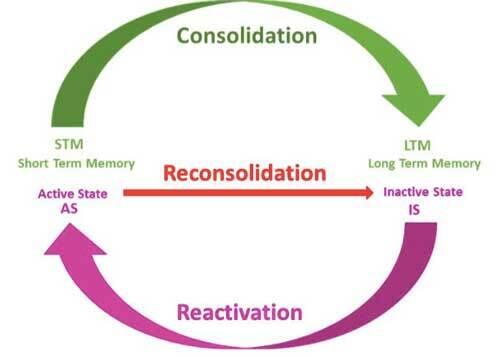
While we often think of learning as an active, wakeful process, most of what we call learning actually occurs while we sleep. It is here where short-term memories are moved into long-term storage
Before a full night sleep or even a nap, we fetch recently learned information from our hypo-campus. But it is during sleep where the real work of learning happens through memory retention, memory consolidation and selective forgetting. Nap experiments have shown a 20% advantage of sleep for memory retention.
Memory consolidation describes this process of taking the fragments of new information and integrating them. During a nap or night of sleep, our short-term memories literally get “moved” to a different region of the brain, the neocortex. This happens during Non-REM sleep, basically the non-dreaming phase of sleep associated with slow brainwaves. Memory consolidation occurs then as we shift newly learning information from short-term to long-term memory.
Further evidence of the importance of sleep and learning was gleaned from some rather cruel studies. In one case, two groups were given the same learning challenge, learn a list of words. Afterwards, one group got to take a nap (or full night sleep in a similar study) while the other stayed awake the whole time. After a similar break period of several hours, both groups were tested on their retention. The people who were prevented from sleeping or didn’t get a nap, saw their learning affected. Memories were much better in the group who got to sleep. Sleep it was revealed provides a 20-40% benefit to the strength of a memory. Additionally we see evidence of the benefits of sleep on creativity and innovative thinking sleep too.
In order to truly learn something we need to move it from the short-term storage in our hypo-campus and connect and move it into our long-term memories in the neocortex. In short, in order to learn, we need to sleep!
Chunking and Getting The Big Picture: Two Ossilating Steps When Learning
The course also highlights an aspect of learning I hadn’t realized the importance of before, and that’s the importance of both top-down and bottom up learning. Top down learning describes understanding the big picture. For example how does a single concept fit in the general conceptual map of related ideas? Where does one fact go with other parts of that story or field? Having a top-down or big picture understanding allows you to put the main ideas into a conceptually linked map of the ideas and how they fit together.
Learning is a two-way street where you should consider both the context or big picture where things fit and the bottom up where chunks fit into the context.
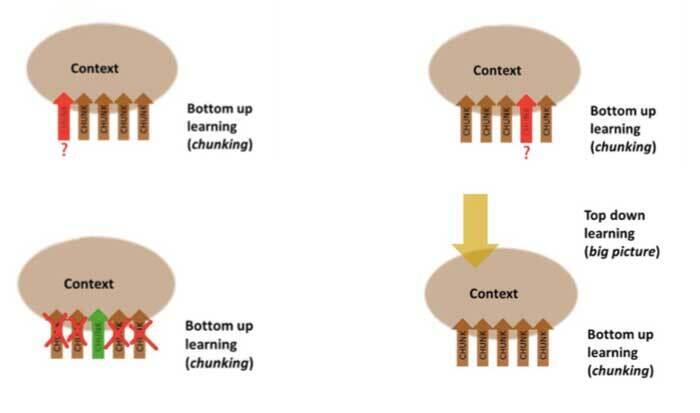
In contrast, bottom up learning, which is also called “chunking” in the course, describes when you learn a more specific or focused concept. Chunks are pieces of information that bound together through meaning or use. You might think of it as an atomic idea or definition. A lot of learning is developing a sufficient repository of these chunks. In language learning this would largely be learning lots of vocabulary and in other fields it might be learning vocabulary as well as formulas and other skills.
Building on our original idea of two kinds of thinking (diffuse vs focused), the course emphasizes leveraging these two modes when learning both chunks and the big pictures since both are key to truly understanding something. You learn chunks through the focused model of thinking and learning, and you develop the broader conceptual map using diffuse way of thinking.
Initially, it’s a good idea to learn the basic outline and core structure, before filling in the details. This could involving looking at the table of contents and scanning through the figures in a textbook or article. The course discribes doing a “picture walk” where you get a broad sense of a chapter or topic before going through it in detail. This process gives you context to then add details. Next you would want to use focused reading where you attempt to master and build up specific aspects one by one. At the same time, you
Essential steps are this: chunks are best built and mastered with focused attention, while also ensuring you take some time to build up your understanding and practice in elaborating the big picture and context.
One interesting aside mentioned in the course is that getting blocked and even regressing is not that uncommon when learning. This is at least in part due to the cognitively expensive changes going in your brain as you remap concepts. One common mistake that learners make is to refuse to move on in their reading until they fully understand the material in the book in front of them. But sometimes skipping ahead can help. Taking a break, sleeping, exercise, and intermingling new areas gives your brain time to put the pieces into order again.
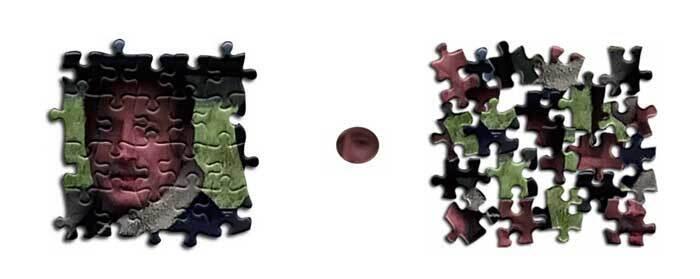
Connections are the key to learning both in a practice sense and a biological one
Learning is a form of connecting and elaborating, deepening and broadening. We are a web of associated information and when we learn (and think for that matter), we leverage these networks. Our brain may not be as fast a computer which operates close to the sleep of light. In contrast, our nerve impulses travel at an comparatively slow pace of about 320 km or 200 miles per hour. That said, our brains take advantage of both parallel processing and the power of complexity in a network.
We shouldn’t forget that learning is an actual process where mental events of learning occur. Several biological and cognitive functions are critical to actually learning. That’s why our mental and physical health are crucial for learning. Multiple studies show how exercise and sleep are just as important as the actual learning time itself. Our brain is “scratching” and syncing together neurons in our brain to create memories. Failure to get enough sleep or feeling stressed inhibit many biological pathways built to help us learn.
Without sleep, we are limited to what is stored in our working memory and are hindered from adding more memory and strengthening memories we have. Exercise offers a mechanism too where we increase blood circulation, and our brains can advantage of improved blood flow to make better connections and replenish the fuel for neurons in the brain to be attentive and learn.
Ultimately, learning and creativity are not linear processes. This is partially due to the complexity of working out all of the related connections and gaps. We learn and are creative because of the complex networks in our brain that take a lot of our energy to build and maintain. This network building in learning and creativity is why we need to sleep too.
The importance and cost of a complex network also points us towards the reasoning why certain learning techniques work and others don’t. For example, re-reading, summarizing and underlining are some of the most popular ways to learn. But they are also some of the least effective. They are easy and make you feel like you are making progress, but they don’t force you to recall, check for gaps or connect new information with your existing ideas. They are classic examples of activites that give you the illusion of competence.
By contrast, techniques like elucidating and testing remain some of the best because they provide feedback and force you to bring new information into your existing network of knowledge. These two methods combined with general learn strategies of intermingling, mixing up your practice and scheduling prove effective because they create challenges and provide opportunities to bridge new ideas with older ones. These learning strategies work too because you space learning out over time so you get some rest and sleep.
Testing and elucidation are are admittedly hard. But that’s why they prove more useful for learning since learning at the end of the day takes effort and time (and sleep!).
Conclusion
In this post we looked at the the benefits to learning about learning as well as some of my favorite resources on the topic. We then looked at a short account of how learning and memory works.
For me, the optimal process for learning something remains an open question. There is a lot of expert advice on learning and I follow certain techniques that I find work well for memory retention, maintaing my motivation, and developing the learning habit.
Personally I think we need to study things that interest us. If we don’t like a topic or are not interested in a certain skills, then it is pretty hard to expect to make much progress. This is well-backed up by the science of goals too.
While there are some clear science behind effective learning techniques, I still think learning is a highly personal process and you need to know yourself and how you learn best. We should definitely aim to follow the recommended learning techniques like elaboration, self-explanation, and testing. But we should also use resources and techniques we like too. Research has shown that stress is not good for learning and we learn best when we bring positive emotions and moods to our learning. So it makes sense to follow learning methods we like and enjoy, even if they are not scientifically-speaking the most effective.
For me one big gap remains in my thinking and practices around learning, and that’s tracking. For example, how can we track our learning? Specifically I wonder: How can we quantify our learning both in terms of the content of what we learn and the process we deploy for learning?
Questions are:
- How to track and quantify our learning process?
- How to track our learning progress, knoweledge and skills?
For as much time as I spend learning, I’d love to have a better way to quantify all of this learning time. I’d love to see a clearer story in data between starting to learn a new topic and eventual mastery. It seem crucial that we reveal these gaps of what we haven’t learned or areas that remain error-prone.
Additionally, I’d love to be able to track the effectiveness of the different techniques, the correlation between sleep, exercise and lifestyle and learning. I think tracking can help us tease out what is actually happen during our learning, and tools like Anki might provide a starting data point of our flashcard learning history. That said, many open questions remain on how we learn and how we might quantify it. Yet tracking learning and providing great feedback to learners (and teachers) is one of the most important goals we should work on in education.
For me one of the chief benefits to learning about learning was that I’m now more confident in my approach and efforts at learning. Combined with how to take smart notes, it taught me more about how our memories works and also how important our health, fitness, and most importantly sleep is to learning too. I now try to get better sleep and exercise since I realize that it isn’t just how much time you spend on learning itself but also how long you spend sleeping that matter too. Hopefully, by learning how and what learning is you too can become more confident in your learning.
Best of luck and happy learning!

